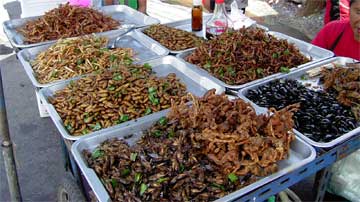|
| |
Entomophagy is the practice of eating insects.
The word “entomophagy” derives from the Greek term éntomos, or
éntomon, meaning,
“insect(ed),” literally meaning “cut in two,” referring to an insect’s segmented
body, and phăgein, “to eat.” Combined, the two terms mean, “insect eating.”
Insects have served as a food source for people
for tens of thousands of years, all over the planet. Today insect eating is rare
in the developed world, but insects remain a popular food in many developing
regions of Central and South America, Africa, and Asia.
People from Thailand, Vietnam, Cambodia, China,
Africa, Mexico, Columbia and New Guinea to name just a few, are regions where
the inhabitants eat insects for nutritional value as well as for taste.
Some of the more popular insect and arachnids
eaten around the world are: crickets, grasshoppers, ants, a variety of species
of caterpillar, also referred to as worms, such as the mopani worm, silkworm and
waxworm, and last but not least scorpions and tarantulas.
There are an estimated 1,462 species of recorded
edible insects including arachnids. And in all likelihood, there are hundreds if
not thousands more that simply haven’t been sampled or perhaps not even
discovered yet.
According to the Entomological Society of
America insects generally contain more protein and are lower in fat than
traditional meats. In addition they have about 20 times higher food conversion
efficiency than traditional meats. In other words they have a better
feed-to-meat ratio than beef, pork, lamb or chicken.
Risks: Practicing entomophagy
does carry certain risks. Of course the same is true of most other kinds of food
consumption; even foods produced by conventional commercial methods can have
adverse health effects, as can be seen when perusing the news media.
Yet the toxicity of unknown species of insects
(and there are toxic species in nearly every family of insects) is not the only
potential issue. Most of the insects eaten around the world are wild-harvested,
which means that no one can be sure of what the insects themselves have been
exposed to.
Most agricultural methodologies include vast
amounts of pesticides and other toxins. Where and how insects live and feed is
quite important: even cicadas, which are sedentary for most of their lives, may
have fed from roots of trees that absorbed fungicides or lawn chemicals or etc,
etc.
An example of precautionary measures are simply
that if you are allergic to shellfish or shrimp or even chocolate, it is
probably best to avoid eating insects, until you figure out your tolerance
levels. One should also never eat raw insects unless they’ve been bred and
raised by a trusted source; because it is impossible to detect if a raw insect
is tainted with pesticides.
In addition it is also difficult to know if a
raw insect is carrying germs and lastly some insects store certain compounds
that may cause sicknesses; just as some insects are poisonous. It is always
better to be safe than sorry; know your source. A safe source equals a healthy
diet - in all cases of the food industry
Insects have served as a nutritional, tasty and
safe food source for people for tens of thousands of years, all over the planet.
Today insect eating is rare in the developed world, but eating insects is a
common practice in over 13 countries. Insects remain a popular food in many
developing regions of Central and South America, Africa, Australia and Asia.
It’s only a matter of time till Eurocentric based cultures, like the United
States, Canada and Europe catch on
How many insects are
edible?
There are an estimated 1,462 species of recorded
edible insects according to the Food and Agriculture Organization of the United
Nations (FAO).
How nutritional are
they?
Insects are very nutritional; they tend to be
high in protein and low in carbohydrates. Let’s take the cricket as an example:
100 grams of cricket contains: 121 calories, 12.9 grams of protein, 5.5 g. of
fat, 5.1 g. of carbohydrates, 75.8 mg. calcium, 185.3 mg. of phosphorous, 9.5
mg. of iron, 0.36 mg. of thiamin, 1.09 mg. of riboflavin, 3.10 mg. of niacin and
.05% fat.
Compare that with 100 grams of ground beef,
which, although it contains more protein, about 23.5 g. to be exact, it has
288.2 calories and an enormous amount of fat, in fact 21.2 grams worth! Lou
Sorkin, Advisor for Insects Are Food, would like to add that like any food, how
you prepare them can change their status from healthy to not so healthy.
Deep-frying them or using them only as a novelty in a sugared or chocolate
coating might be tasty, but then you're eating a junk-food preparation, albeit a
tasty one.
The difference however between a regular chocolate
chip cookie and one made with crickets is that the one made with crickets has a
lot more protein! It’s a no-brainer to choose the chocolate chip cookie with
crickets (or as entomophagists call them, “chocolate chirp” cookies) over any
other brand!
What do insects
taste like?
We here at Insects Are Food all have slightly
different answers to this question because of our individual taste buds and
taking into consideration the fact that the ingredients used in each recipe,
naturally has the potential to influence and enhance the taste of the insect.
Can you eat bugs
collected from in and around your home?
People who know their insects and the care
needed to harvest them from the “wild,” can collect bugs from local areas such
as one’s yard, local parks, woodlands, in and along streams and rivers or even
on the beach. Otherwise they should only be purchased from reliable and trusted
sources.
How safe are bugs to
eat; are there any we shouldn’t eat?
Bugs are safe to eat as long as you purchase
them from a reliable source or raise them yourself. You do not want to take bugs
from the wild because you don’t know what sort of pesticides or other chemical
sources they’ve come into contact with. A good rule of thumb to follow is to
avoid eating any brightly colored, hairy or spiny bugs, as they are likely to be
poisonous. Most caterpillars are similarly inedible. In all cases of food
consumption, a safe and reliable source equals a safe and healthy diet.
What is the most
popular insect to eat?
It appears crickets are one of the more popular
insects to eat. It is one of the easiest to raise, prepare and cook. They’re
very inexpensive to raise and easy to maintain. They’re also highly nutritious
and tasty. Mealworms and silkworms are also very popular. It would make for an
interesting project for someone to find out which bugs are indeed the most
popular to eat. We’d love to hear the responses.
How do I prepare
bugs for consumption?
First off, insects should only be purchased from
reliable sources and kept fresh as possible. Prior to preparing your live
insects for a meal, place them inside a storage bag and keep them in the
refrigerator between a half hour and an hour up until the time you are ready to
use them. Refrigeration will not kill insects, but just slow down their
metabolism, prohibiting their movement when removed from the refrigerator. Some
people place them in a pot of boiling water for about two minutes ensuring
cleanliness. They can be used in any number of recipes without boiling so long
as they’re cooked, i.e. roasted, sautéed, fried, etc. Any insect after boiling
and/or cooking can be stored in your freezer for later use much like any other
food.
( Courtesy :
Insects are food )
| |
|



